Specific behaviors exhibited by tarantulas at night

When the sun goes down, tarantulas start to show their true selves. These amazing arachnids are most active at night. They have special ways to hunt, defend themselves, and even find a mate in the dark.
We’ll take a closer look at tarantulas’ nighttime world. You’ll learn about their hunting, territorial behavior, and how they protect themselves. Get ready to be amazed by these creatures’ nighttime adventures.
Nocturnal tarantula hunting patterns
When the sun sets, tarantulas start their hunt. They are mostly active at night, using the dark to their advantage. Tarantulas have clever ways to find and catch their prey.
Prey Detection Tactics Used by Tarantulas at Night
Tarantulas have special senses to find prey in the dark. They use sensitive hairs and organs that feel. These help them track insects and small animals.
Some tarantulas, like the Goliath birdeater, can feel the vibrations of footsteps. This lets them find their next meal with amazing accuracy.
Tarantula Ambush Strategies in the Dark
Tarantulas are experts at setting up ambushes. They wait in their burrows or at web entrances to catch prey off guard. Their stillness and quick reflexes make them great hunters in the dark.
The Mexican redknee tarantula (Brachypelma smithi) can stay still for hours. Then, it quickly bites and paralyzes its prey with venom.

Nocturnal tarantula hunting shows their amazing evolution. It gives us a peek into their secret world.
Tarantula territoriality and burrowing habits at night
As night falls, tarantulas show off their territorial and burrowing skills. These spiders are big and unique, living alone in their own burrows. Each spider has its own home underground.
Their burrows can be huge, sometimes going deep into the ground. These tunnels are where tarantulas hide from danger and hunt for food. They are safe from predators and harsh weather.
Tarantulas are very protective of their homes. They fight off anyone who tries to enter. Sometimes, these fights can get very serious. Males, looking for a mate, often have to go through many burrows, facing other tarantulas along the way.
Things like food and how crowded the area is can change how tarantulas burrow and defend their territory. Research shows that tarantulas can behave differently depending on where they live. This shows how flexible and complex their nighttime lives are.
| Behavior | Description | Significance |
|---|---|---|
| Burrowing | Tarantulas construct intricate underground tunnels and chambers, serving as their nocturnal homes and hunting grounds. | Provides protection from predators and the elements, as well as a strategic location for hunting and breeding. |
| Territoriality | Tarantulas aggressively defend their burrows and web-building sites from potential competitors or intruders. | Ensures access to valuable resources and mates, contributing to their survival and reproductive success. |
| Nocturnal Activity | Tarantulas exhibit heightened activity levels during the night, with behaviors such as hunting, mating, and burrow maintenance. | Avoids daytime predators and takes advantage of cooler temperatures and increased prey availability at night. |
The way tarantulas burrow and defend their territory is amazing. It shows how well they have adapted to survive. Learning about their nighttime habits helps us understand these fascinating spiders better.
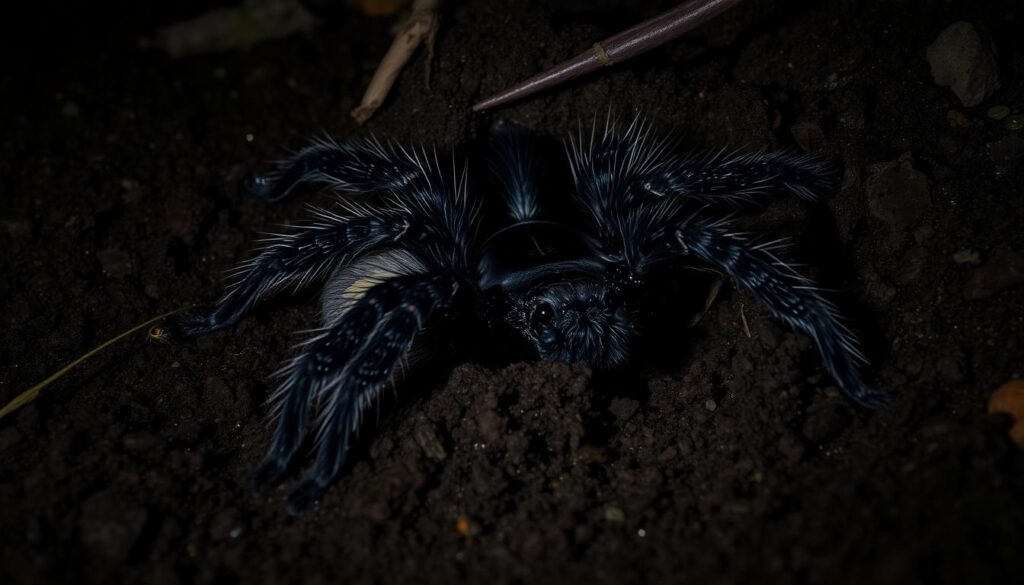
Tarantula defense mechanisms during nighttime
When night falls, tarantulas become active, using impressive ways to defend themselves. They have tarantula defense mechanisms at night. These include threat displays by tarantulas and the use of tarantula venom.
Threat Displays and Venom Use by Tarantulas at Night
When they sense danger, tarantulas show off with bold displays. They lift their front legs, spread their fangs, and rub their hind legs against their belly. This makes a hissing sound.
These actions make the tarantula seem bigger and scarier. It tries to scare off any predators. But if danger doesn’t go away, tarantulas use their venom.

With their dramatic displays and venom, tarantulas are strong nighttime hunters and defenders. Learning about their tarantula defense mechanisms at night helps us appreciate their amazing survival skills.
Specific behaviors exhibited by tarantulas at night
Tarantulas have amazing behaviors at night. They show off their hunting skills, defend their territory, and even mate in the dark. Their web-building and mating rituals are truly mesmerizing.
At night, tarantulas are master web-builders. They create complex webs to catch prey. Their skill in building these traps is a wonder to see.
They also have special mating rituals at night. These rituals involve dances and signals to attract mates. It’s amazing to watch them coordinate their moves.
Another cool thing about tarantulas at night is how they move. They have special senses and vision that help them navigate in the dark. They can move with great agility and precision.
| Nocturnal Tarantula Behaviors | Description |
|---|---|
| Web-building | Intricate web construction techniques under the cover of night |
| Mating Rituals | Elaborate courtship and reproduction behaviors during nighttime |
| Locomotion Adaptations | Enhanced sensory and visual capabilities for navigating low-light conditions |
Exploring tarantulas’ night behaviors shows us their amazing adaptations. Their web-weaving and mating dances are incredible. Tarantulas truly shine in the dark, revealing the wonders of nature’s night creatures.
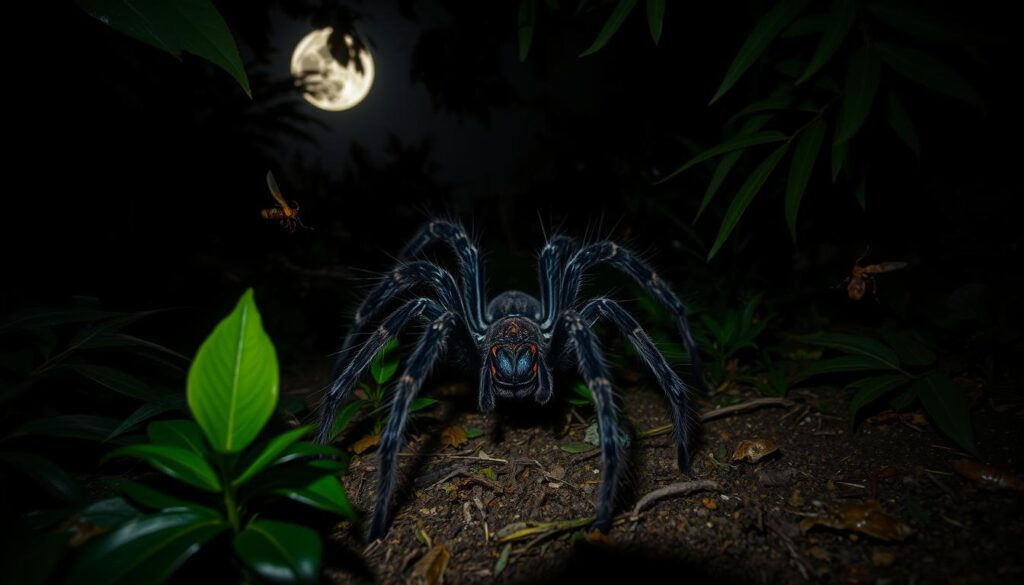
 Degree of socialization and gregarious behavior in tarantulas
Degree of socialization and gregarious behavior in tarantulas
Locomotion adaptations of tarantulas for low-light conditions
Tarantulas are big, fascinating spiders with unique looks. They have special ways to move around at night. These help them live well in the dark.
How Tarantulas Navigate in Darkness
Tarantulas have special senses to move in the dark. They have hairs all over their bodies. These hairs help them feel even the smallest touches.
They also have organs called slit sensilla. These are on their legs and body. They help tarantulas feel vibrations, making it easier to move in the dark.
- Tarantulas have special senses like hairs and slit sensilla to feel their surroundings in the dark.
- These senses help them move and navigate in the dark.
- Tarantulas move slowly and carefully to safely explore their dark homes.
Thanks to these amazing abilities, tarantulas can move around at night with great skill. They are excellent hunters and finders in the dark.
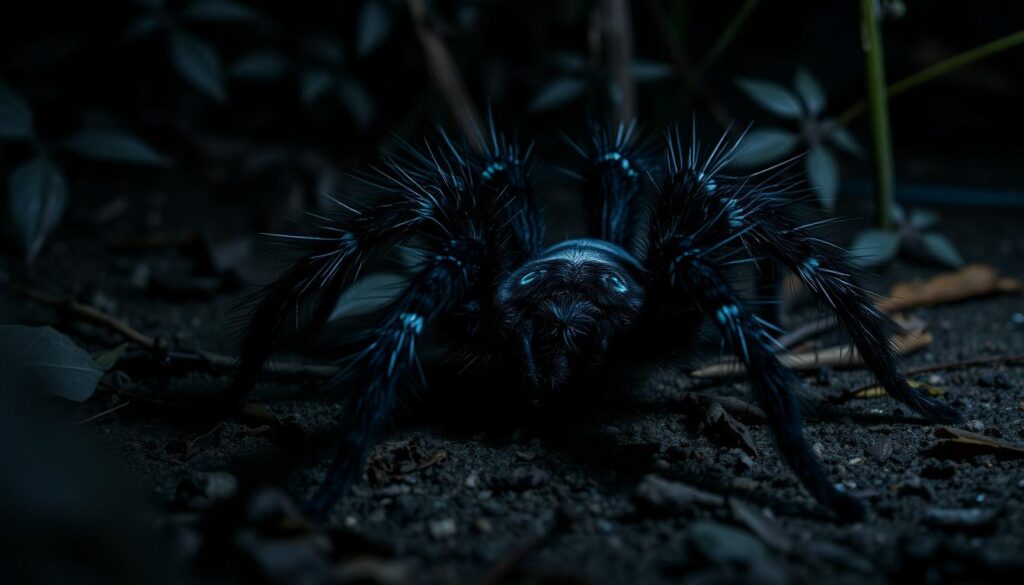
Nocturnal web-building by tarantulas
Tarantulas are amazing arachnids known for their size and look. They are experts at building webs at night. Their webs are a key part of their life, helping them catch prey and find shelter.
Purpose and Techniques of Nighttime Web Construction
Tarantulas make webs for different reasons. They use them to catch food, find a safe place, and even for love. They use special silk and move in a special way to make these amazing webs.
Each tarantula has its own way of building a web. Some make funnel-shaped webs to catch prey. Others create orb-shaped webs to catch flying bugs.
The size and detail of a tarantula’s web can change based on its age, gender, and where it lives. Older, bigger tarantulas make more complex webs. Younger or smaller ones make simpler ones to survive.
Building webs at night helps tarantulas hunt and protect themselves. It also helps them fit into their ecosystem and keep nature in balance.

| Tarantula Species | Web Construction Techniques | Web Purpose |
|---|---|---|
| Funnel Web Tarantulas | Construct funnel-shaped webs to ambush prey | Hunting and shelter |
| Orb-Weaving Tarantulas | Build intricate, circular orb-shaped webs to trap flying insects | Hunting and mating |
| Burrowing Tarantulas | Create simple, tube-like webs at the entrance of their burrows | Shelter and protection |
The way tarantulas build webs at night is truly fascinating. It shows how well they adapt and their important role in nature. Learning about their web-building helps us understand these mysterious creatures better.
Tarantula mating rituals under the cover of darkness
When night falls, tarantulas come out to play. Tarantula mating rituals at night are a magical sight. They show off their courtship, negotiation, and reproduction skills.
Male tarantulas, like the Texas Brown Tarantula, look for females at night. They can mate with up to 100 females in a season. This season is from August to October. Females can lay hundreds of eggs a year and live up to 30 years.
The mating dance is complex. Males use special moves and vibrations to attract females. They communicate through touch and chemical signals, all in the dark.
Despite poor eyesight, tarantulas have other ways to find mates. They use vibrations, touch, and pheromones. This shows how well they adapt to the night.

Interestingly, tarantulas are not aggressive, even when mating. They are not a threat to humans unless they are provoked. This makes them great to watch and study at night.
Impact of moonlight and artificial lighting on tarantula behavior
Tarantulas are active at night, and moonlight and artificial lights can change their behavior. These factors affect how they hunt and build webs.
Tarantulas are used to dark places. Bright lights can mess with their natural ways. Research shows they hunt less when the moon is full because they feel safer in the dark.
Artificial lights at night attract more predators like tarantulas and beetles. This can upset the balance in ecosystems. It might make predators have more control over their prey.
| Environmental Factor | Impact on Tarantula Behavior |
|---|---|
| Moonlight | Reduced foraging and activity levels due to increased perceived predation risk |
| Artificial Lighting | Increased abundance of ground-dwelling predatory invertebrates, leading to changes in trophic dynamics and ecosystem interactions |
It’s important to know how moonlight and artificial lights affect tarantulas. This knowledge helps in their conservation and keeping ecosystems healthy. By understanding these effects, we can better study and protect these amazing creatures.

Evolutionary advantages of nocturnality in tarantulas
Tarantulas have evolved to be active at night. This helps them avoid predators and competitors that are active during the day. The darkness also lets them ambush prey and mate without being seen. This adaptation has helped tarantulas survive and thrive in many ecosystems.
Being nocturnal helps tarantulas avoid predators. Birds, lizards, and small mammals hunt less at night. Tarantulas can hide in the dark, making it hard for predators to find them.
Nocturnal hunting gives tarantulas an advantage. They can sneak up on insects, arachnids, and small animals in the dark. Their senses, like feeling vibrations and seeing infrared, help them find and catch prey better in the dark.
 How tarantulas use chemical signals to communicate
How tarantulas use chemical signals to communicate
Also, the night is better for tarantulas to mate. They can do their courtship and reproduction without being seen. This increases their chances of successful mating and passing on their genes.
Nocturnality has helped tarantulas succeed in different habitats. From deserts to rainforests, their night-time activities have been key to their success. This adaptation has made them a fascinating part of our planet’s biodiversity.

Tarantula prey preferences and dietary habits at night
Tarantulas hunt at night, catching a variety of prey. They go after insects, small rodents, and other arthropods. Their hunting skills and senses help them catch and eat these prey, keeping them strong.
Common Prey Items for Nocturnal Tarantulas
Tarantulas eat many small animals, including:
- Insects such as crickets, grasshoppers, and beetles
- Arachnids like smaller spiders and scorpions
- Small rodents like mice and voles
- Lizards and small snakes
- Birds and their eggs or nestlings
They catch prey using stealth, speed, and venom. Their sharp fangs and strong jaws help them eat even big prey. This makes them powerful hunters at night.
| Prey Item | Frequency of Consumption | Nutritional Value |
|---|---|---|
| Insects | High | Provide essential proteins and carbohydrates |
| Small Rodents | Moderate | Offer higher caloric content and fats |
| Reptiles | Low | Contain valuable minerals and nutrients |
Learning about tarantula prey preferences at night and common prey items for nocturnal tarantulas helps us understand their tarantula dietary habits at night. It shows their important role in their ecosystem.
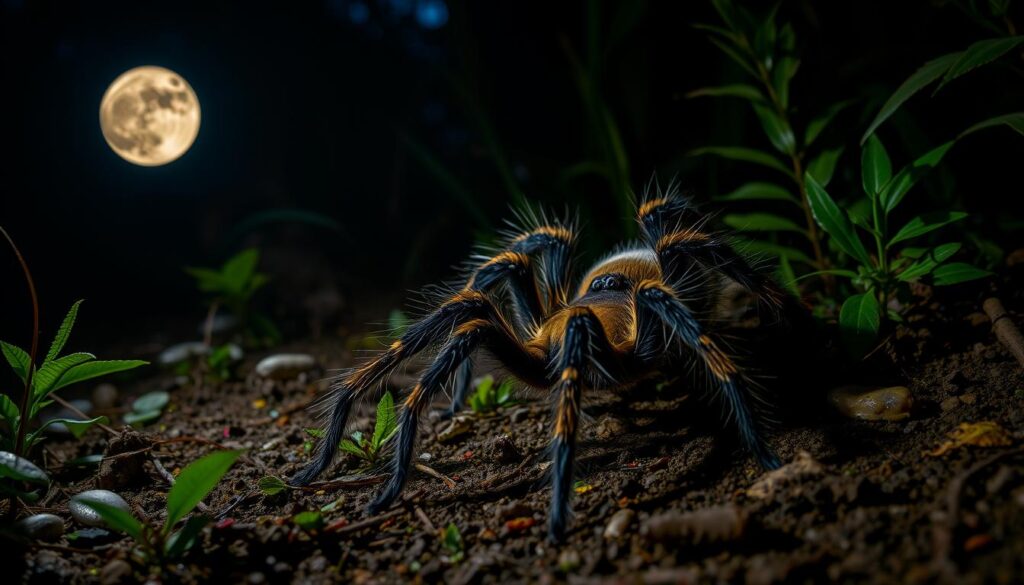
Variations in nighttime tarantula activity across species
While tarantulas are mostly active at night, different species have their own ways of doing things. These differences come from their habitats, what they eat, and their evolutionary history. Each species has its own unique nighttime habits.
For example, terrestrial tarantulas in deserts burrow and ambush at night. In contrast, arboreal tarantulas in tropical forests are more active, hunting and web-building. Their nighttime activities also depend on what they eat, with some scavenging and others hunting a variety of prey.
Evolution has also shaped tarantulas’ nighttime behavior. Some have special senses or ways of moving to hunt better in the dark. Others use threats or venom to protect themselves at night.
| Tarantula Species | Nighttime Behavior | Evolutionary Adaptations |
|---|---|---|
| Desert Tarantula | Pronounced burrowing and ambush behaviors | Specialized sensory organs for low-light conditions |
| Arboreal Tarantula | Active hunting and web-building | Improved locomotion strategies for navigating in trees |
| Scavenging Tarantula | Opportunistic scavenging of small prey | Enhanced venom production for defending against threats |
Studying these differences helps us understand tarantulas better. It shows us how diverse and fascinating these creatures are.

Environmental factors influencing tarantulas’ nocturnal behavior
The world of tarantulas is shaped by many environmental factors, especially at night. Temperature, humidity, predators, and disturbances all play big roles. These factors help determine how and when tarantulas move and hunt.
Temperature is a key driver of tarantula behavior at night. Since they can’t regulate their own heat, they seek warm spots to stay active. Knowing what temperature each tarantula prefers is important for their care.
Humidity also affects tarantulas a lot. They need the right moisture level to stay healthy. If humidity changes too much, they might hide or become defensive.
| Environmental Factor | Impact on Tarantula Nocturnal Behavior |
|---|---|
| Temperature | Regulates metabolic processes and hunting efficiency |
| Humidity | Maintains proper moisture balance and triggers defensive behaviors |
| Predator Presence | Influences burrowing, web-building, and threat displays |
| Artificial Lighting | Can disrupt natural circadian rhythms and foraging patterns |
Predators also play a big role in tarantula behavior. They have many ways to defend themselves, like showing threats or making venom. The fear of predators can change when and how they hunt.
Artificial lights, like street lamps, can mess with tarantulas’ natural night habits. These lights can make them hunt and move differently, affecting their overall activity.

Studying how environment affects tarantulas can teach us a lot. It helps us understand and care for these amazing creatures better. This knowledge is key for their conservation and our appreciation of their unique lives.
Observing and studying tarantulas safely at night
Watching tarantulas at night can be very exciting. But, it’s important to do it safely for both you and the tarantulas. By being careful and respectful, you can learn a lot about these amazing creatures.
Best Practices for Nighttime Tarantula Observation
Here are some key tips for observing tarantulas safely at night:
- Use Appropriate Lighting: Choose low-intensity, red-spectrum lights. They won’t disturb the tarantulas as much. Don’t shine bright lights on them.
- Maintain a Safe Distance: Keep a safe distance to respect their space. Don’t handle them or interrupt their activities.
- Respect Tarantula Territoriality: Remember their burrowing habits and personal space. Don’t disturb their burrows or invade their area.
- Minimize Disturbances: Move slowly and quietly. Avoid sudden movements or loud noises that could stress them.
- Prioritize Safety: Wear gloves and long sleeves to prevent bites. Know the specific tarantula species you’re watching and their defense mechanisms.
By following these tips, you can watch tarantulas at night safely. You’ll also learn a lot about their interesting nighttime behaviors.
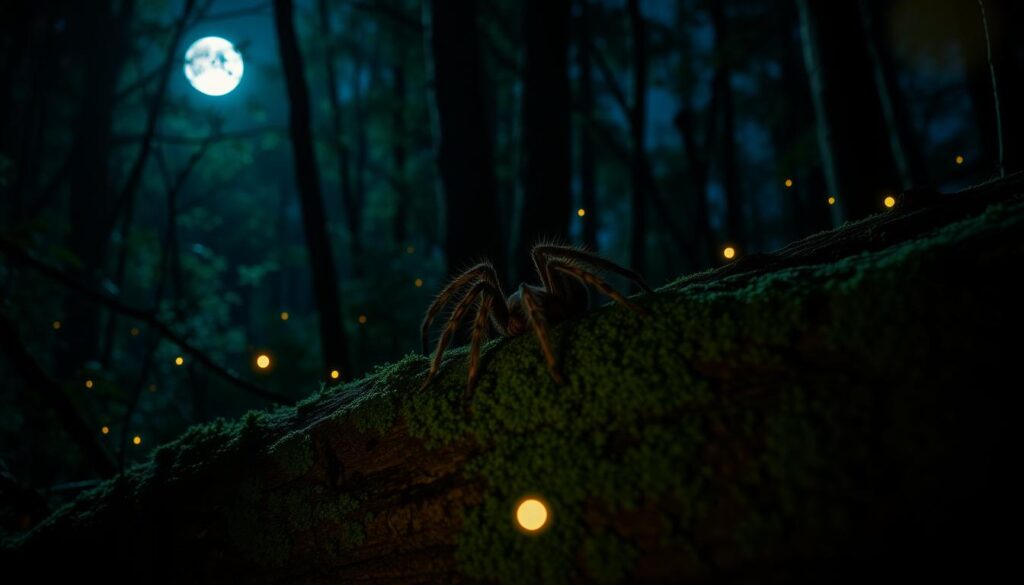
| Lighting Considerations | Distance and Handling | Territorial Awareness | Safety Precautions |
|---|---|---|---|
| Use low-intensity, red-spectrum lighting | Maintain a safe distance, avoid direct handling | Respect tarantulas’ burrowing and territorial boundaries | Wear protective gear, familiarize with defense mechanisms |
Fascinating nocturnal tarantula behaviors yet to be fully understood
Despite lots of research, many tarantula behaviors at night are still a mystery. New technology and research methods are helping us learn more about these arachnids. We’re finding out more about their nighttime activities and abilities.
These spiders are amazing at building webs and hunting. They can move around in the dark and defend themselves. They even have special ways of mating at night. These behaviors are fascinating and need more study.
 Details about tarantula courtship and mating rituals
Details about tarantula courtship and mating rituals
Understanding tarantulas’ nighttime behaviors is an exciting journey. We’re making new discoveries and learning to appreciate nature more. By studying these spiders, we’re uncovering their secrets and how they survive in the dark.



